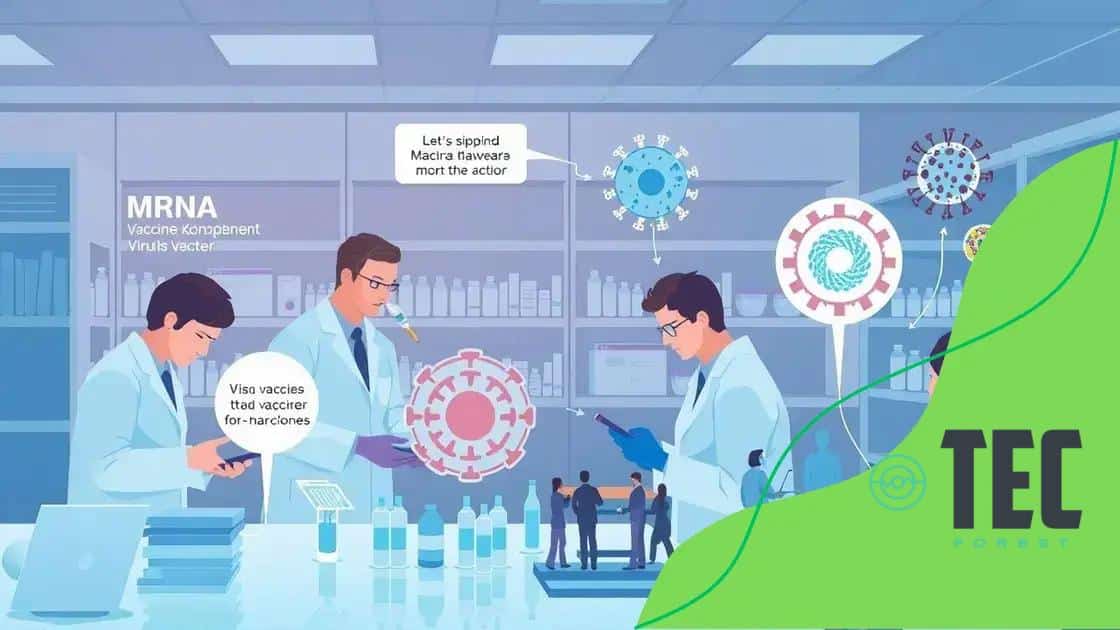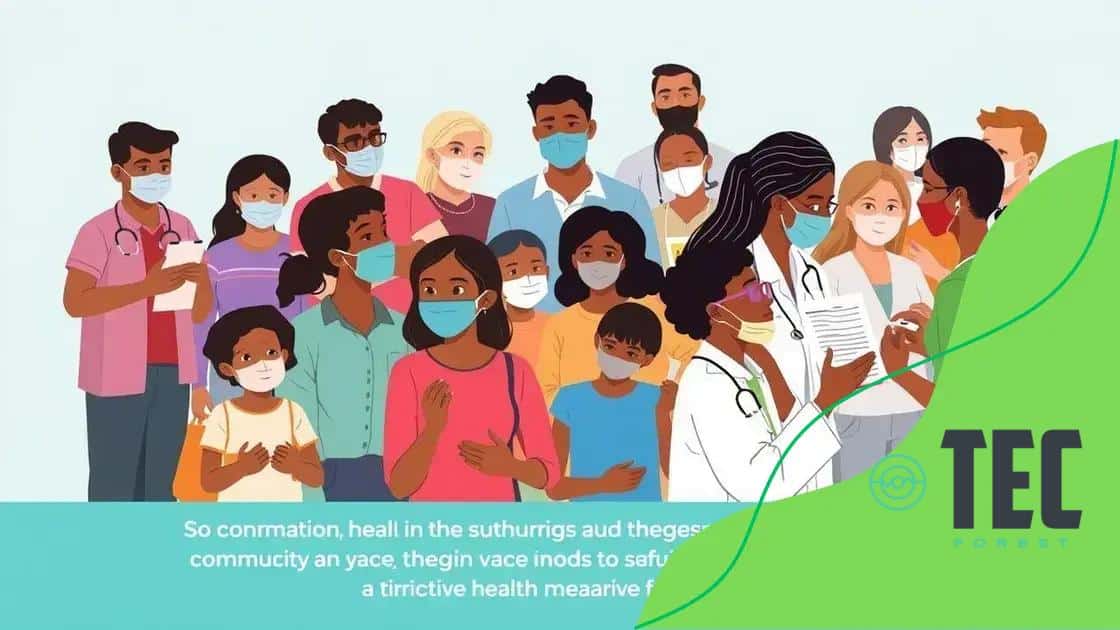Advertisement
New pandemics spark rapid vaccine innovation debates, highlighting the urgent need for global collaboration, advanced technology, and public engagement to enhance health security and preparedness.
New pandemics spark rapid vaccine innovation debates, raising important questions about our preparedness and response. We’ve all seen how quickly viruses can spread, but have you thought about what this means for vaccine development?
Advertisement
The rise of new pandemics: an overview
The rise of new pandemics is a pressing global issue that demands attention. In recent years, we have witnessed the emergence of several infectious diseases that pose significant threats to public health.
Understanding how and why these pandemics occur is essential. Various factors contribute to their emergence, including climate change, urbanization, and globalization. As we study these factors, it’s vital to recognize how interconnected our world has become. For instance, a virus that starts in one region can swiftly spread to another, highlighting the need for global cooperation.
Advertisement
Key Factors in Pandemic Emergence
Several primary factors contribute to the emergence of new pandemics, which include:
- Environmental Changes: Climate change alters habitats and ecosystems, allowing pathogens to thrive in new areas.
- Human Behavior: Increased travel and trade enable diseases to spread more rapidly than ever.
- Urban Sprawl: Densely populated areas can facilitate faster transmission of viruses.
- Animal Interactions: Human encroachment on natural habitats increases contact with wildlife, leading to zoonotic diseases.
Moreover, repeated outbreaks remind us of the importance of surveillance and research in combating these threats. Public health organizations work tirelessly to monitor and respond to these challenges. They employ advanced technology, vaccines, and rapid response strategies to mitigate risks.
In this constantly evolving landscape, fostering awareness is crucial. Communities must be educated on prevention measures and the significance of vaccinations.
In summary, the rise of new pandemics is influenced by diverse factors that intertwine environmental, social, and health dimensions. For effective responses and preparedness, global collaboration and informed public engagement are essential.
How vaccine development has evolved

The evolution of vaccine development has been remarkable, especially in response to the challenges posed by new pandemics. Over the years, scientific advancements have transformed how vaccines are created and distributed.
Initially, vaccines were made using traditional methods that involved weakened or inactivated forms of viruses. This process was time-consuming and sometimes inefficient. However, with the advent of new technologies, a faster and more effective approach to vaccine development has emerged.
Modern Vaccine Technologies
Today, several innovative methods are used in vaccine development, including:
- mRNA Vaccines: These vaccines use a small piece of the virus’s genetic material to instruct cells to produce a harmless piece of the virus, prompting an immune response.
- Viral Vector Vaccines: This approach uses a harmless virus to deliver pieces of the target virus’s genetic material, helping the immune system recognize and attack it.
- Protein Subunit Vaccines: They contain harmless pieces of the virus’s proteins, which stimulate an immune response without using live pathogens.
As we examined these advances, it is clear that improvements in technology have allowed for quicker vaccine development timelines. For instance, the rapid development of COVID-19 vaccines showcased how collaboration among scientists worldwide can lead to effective solutions in record time.
The increased emphasis on research and funding has also played a part in this evolution. Governments and private sectors have realized the importance of being prepared for future outbreaks.
In addition, clinical trials have become more streamlined, employing adaptive designs that allow researchers to modify studies as needed. This flexibility helps accelerate the evaluation of vaccine efficacy and safety.
The future of vaccine development looks promising, with research continually evolving. Innovations in artificial intelligence and machine learning are now being incorporated into the discovery process, offering further enhancements in how vaccines are developed.
The role of technology in vaccine innovation
The role of technology in vaccine innovation has become increasingly vital as we navigate the challenges of new pandemics. Advancements in technology have significantly enhanced our ability to develop effective vaccines swiftly.
One key aspect is the use of computational models. These models help researchers identify potential vaccine candidates by simulating how viruses behave. By understanding these patterns, scientists can target specific parts of a virus to produce a more effective immune response.
Enhanced Vaccine Development Techniques
Several technologies play a crucial role in modern vaccine innovation:
- Genetic Engineering: Techniques such as CRISPR allow scientists to modify the genetic material of viruses, enabling them to create more precise vaccines.
- Data Analytics: Big data helps researchers analyze vast amounts of information, improving the understanding of disease spread and vaccination rates.
- Artificial Intelligence: AI algorithms can predict which vaccine formulations might be most effective, accelerating the research process.
Furthermore, technology has improved the manufacturing process, making it faster and more cost-effective. For example, using cell lines instead of live animals for vaccine production leads to higher efficiency and less waste.
Additionally, digital platforms have transformed how clinical trials are conducted. These platforms allow for better patient recruitment and data collection, ensuring trials are more representative of diverse populations.
The synergy between technology and science has also fostered global collaboration. Researchers from different countries can share findings instantly, expediting the development of vaccines during health crises.
Public response to rapid vaccination initiatives

The public response to rapid vaccination initiatives can vary widely, reflecting a range of attitudes, beliefs, and experiences. During health emergencies, swift vaccination efforts are crucial, but they often encounter challenges.
Some people support vaccination campaigns, seeing them as a vital measure to control infectious diseases. They appreciate the rapid development of vaccines and understand the need for prompt action. Awareness campaigns and trust in healthcare professionals play significant roles in shaping positive responses.
Factors Influencing Public Response
Several factors influence how the public reacts to vaccination initiatives:
- Access to Information: Clear, transparent communication helps educate the public about vaccines and their benefits.
- Trust in Authorities: Confidence in health organizations and government agencies can promote acceptance of vaccines.
- Cultural Beliefs: Different communities may have varying beliefs about healthcare practices, influencing their willingness to accept vaccines.
- Personal Experiences: Individuals’ past experiences with healthcare and vaccines can impact their current attitudes.
While many embrace vaccination, others exhibit hesitancy or resistance. Misinformation can contribute to fears and doubts about vaccine safety and efficacy. Addressing misinformation and providing factual information is crucial to overcoming this skepticism.
Additionally, grassroots movements and community leaders can boost public confidence. When trusted figures promote vaccinations, it often leads to higher acceptance rates. This community engagement fosters a supportive environment where vaccination becomes a shared goal.
Ultimately, understanding and addressing the diverse perspectives within the public is essential for the success of rapid vaccination initiatives. Tailored approaches that consider community needs and values can significantly enhance overall vaccination rates.
Future implications for global health security
The future implications for global health security are becoming increasingly significant as the world faces ongoing challenges from emerging pandemics. Understanding these implications is crucial for improving preparedness and protecting public health.
As we look ahead, it’s essential to recognize that diseases know no borders. The interconnectedness of our world necessitates a collaborative approach. Countries must work together to share information, resources, and technologies to respond effectively to health threats.
Key Areas to Address
Several critical areas will shape global health security in the future:
- Strengthening Surveillance Systems: Enhanced monitoring of diseases can detect outbreaks early, allowing for faster responses.
- Investing in Research: Continued investment in research and development of vaccines and treatments is vital to stay ahead of pathogens.
- Building Healthcare Infrastructure: Developing robust healthcare systems, especially in low-resource settings, can improve resilience against health crises.
- Fostering Global Cooperation: International partnerships and agreements can facilitate rapid responses to public health emergencies.
Technological advancements also play a crucial role in shaping health security. Innovations such as artificial intelligence and big data analytics can provide valuable insights into disease patterns and vaccine efficacy, making responses more effective. Moreover, incorporating telehealth services can ensure that communities receive the necessary support during crises.
Education and communication are equally important. Raising public awareness about health risks and the importance of vaccination can enhance community engagement and trust in health initiatives.
Ultimately, prioritizing these areas will not only help mitigate the impact of future pandemics but also strengthen global health security overall. By taking proactive measures, we can build a healthier, safer world for everyone.
In conclusion, the future of global health security hinges on our ability to adapt and respond to the challenges posed by emerging pandemics. By prioritizing collaboration, investing in technology and infrastructure, and fostering public trust, we can create a more resilient health system. Awareness and education play crucial roles in encouraging proactive behavior. Ultimately, by working together globally, we can ensure a healthier future for all.
FAQ – Questions About Future Global Health Security
What are the key factors for improving global health security?
Key factors include strengthening surveillance systems, investing in research, building healthcare infrastructure, and fostering global cooperation.
How does technology play a role in health security?
Technology enhances disease detection, accelerates vaccine development, and improves data analytics for better responses to health threats.
Why is public awareness important in vaccination initiatives?
Public awareness fosters trust in health programs and encourages people to participate in vaccination campaigns, which is crucial for controlling diseases.
What role does community engagement have in health initiatives?
Engaging local communities and leaders helps tailor health initiatives to specific needs, increasing acceptance and participation in vaccination programs.
